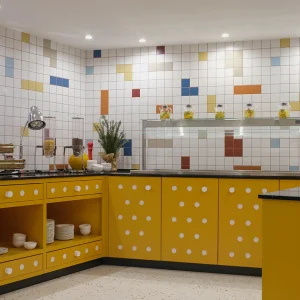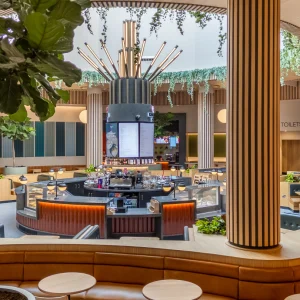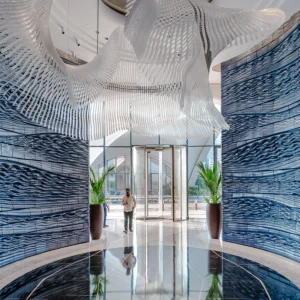
Once upon a time, hotel guests more or less knew where they stood, or slept. The hotel groups provided secure, largely consistent and completely predictable accommodation around the world, and the star-rating system, allowing for global variation, pretty much told them what they would get, from the size of the bedroom and the number of wash basins in the en suite to whether they could order room service at 3am and expect their TV to be concealed in a gilded armoire.
Hotel groups marketed themselves on sameness across their estate – a reassuring concept, we were told, for all those busy road warriors who wanted to know that the bedroom desk in Buenos Aires would be the same size and in same place as the desk in their hotel in Barcelona. Designers – even those lucky enough to be working on luxury hotel projects – were frequently assured that guests did not notice the interior design anyway and while, of course, there were a number of glamorous and beautiful hotels, for most people the hotel experience was merely functional – bed, bath and buffet breakfast.

Originally completed in the early Nineties, the Kempinski Hotel Corvinus, part of a global operation, now has a new lobby (designed by MKV Design) that creates a sequence of unique and inviting spaces
Then it all started to change, led by visionary independent hoteliers such as Ian Schrager (Morgans, Royalton and Paramount), Ken McCulloch (Malmaison) and Tim and Kit Kemp (Charlotte Street, Haymarket and Soho hotels). The discovery was made that hotel guests, at least those who were on a leisure break, were interested in their hotel environment and expected it to be as comfortable and well kitted-out as their home. So the mantra for hotel designers became ‘the creation of a home-away-from-home’. Slowly, the hotel-design rule books were put to one side.
It proved possible to create a hotel guest room that felt very luxurious but was only 25 sq m; the hotel lobby was recalibrated as a revenue generator both in its own right and as a style beacon for the rest of the hotel; locals proved willing to abandon the pub for an extravagantly designed hotel bar and, yes, all those dark patterned carpets had to go.
Where the boutique-hotel pioneers led, the hotel groups sought to follow with strategies to target specific segments of the marketplace, and design became a significant weapon in their arsenal. The innovators of today are now pushing the design boundaries further, using design not in a flimsy, faddish way but to engage guests, elicit a response and create new communities.

The Gstaad Alpina aims at creating an all-year-round alpine experience, marrying rustic with refined
Hotels have become an incubator for new ideas – how we work, what we eat, how we interact with one another and what we learn. While hotels must continue to provide the creature comforts that their particular users want, design is increasingly about offering an experience precisely because it is different from that which they would have at home.
Ace Hotels has been credited as one of the groups out in front. ‘We are not here to reinvent the hotel, but to readdress its conventions to keep them fresh, energised, human,’ says its website’s Welcome page. With five hotels in the USA and one in Panama, the group has just opened its first European property in Shoreditch, London where tech-savvy entrepreneurs rub shoulders with young designers and East End grit mingles with a new crop of fashion boutiques and smart restaurants.
Universal Design Studio was charged with translating the Ace brand for London and helping to create a dynamic neighbourhood hotel in a somewhat unprepossessing existing hotel building. Notably, the studio had never designed a hotel before; significantly, the practice is based in Shoreditch and most of the team lives there.

The Gstaad Alpina aims at creating an all-year-round alpine experience, marrying rustic with refined
Jason Holley headed up team. ‘The best we could say about the building was that a lot of people hadn’t even noticed it before, it sort of sank back from the pavement, but on the upside the internal guest-room layout was good and we had the location. This became our inspiration – its industrial, artisanal and rich theatrical heritage. We have sought to knit the building back into the urban fabric, reanimating it at street level and bringing activity to the front of the hotel.
‘Ace is about being part of something and the lobby is key to this – a hub for people working in the area – so we introduced a 16-seat communal work table, which is a bespoke piece of cast iron, oak and copper. In a sense it is the signature of the hotel, clearly visible through the front windows, which will encourage the local community to come into the hotel and use the lobby,’ he says.
Universal’s approach for the guest rooms was to think of them as a friend’s Shoreditch apartment with a collection of furniture and objects that had been acquired over time, each with distinct stories and memories. So guests find a curated shelf that introduces ‘the experience of Shoreditch’, including useful crafted items such as a map and sketch pads from local suppliers, as well as records, books, magnets and a pin-up cork board, and guests are encouraged to add to the collection during their visit. ‘The Ace Hotel is open and egalitarian but it is not for everyone, and that’s just fine,’ adds Holley.

In its first hotel Universal Design Studio translated the Ace Hotel brand into a locally centred, dynamic neighbourhood hotel in Shoreditch, London
Ace Hotels is far from the only group to be using its lobbies as multi-event spaces and brand statements. Modern hotel lobbies are now flowing spaces that often segue into lounges, bar or restaurant, where furniture, lighting and accessories, rather than walls, indicate zones for different activities, and major international brands as well as niche lifestyle hotel groups are adopting this approach.
A recent example among the global operators is the Kempinski Hotel Corvinus, Budapest. Originally completed in 1992, its lobby has just been boldly redesigned by MKV Design to meet the expectations of luxury-hotel guests and create a sequence of unique and inviting spaces.
The designers chose to amplify the vast scale of the lobby while harmonising the various forms and levels that existed and liberating space to achieve a bar with a street entrance. The lobby has become a glowing expanse that flows from the main porte cochère to reception, offering beguiling views through the cafe and restaurant to the second entrance on the opposite side of the building, drawing visitors into the heart of the building.

In its first hotel Universal Design Studio translated the Ace Hotel brand into a locally centred, dynamic neighbourhood hotel in Shoreditch, London Photo credit: Andrew Meredith
While there are many successful examples of contemporary hotels that offer little or no dining provision, for those that do competition has never been greater and design ranks a close second to the chef in ensuring that the hotel restaurant becomes a destination in its own right.
Sur Mesure par Thierry Marx, named Best Restaurant Design in last year’s European Hotel Design Awards, is a noteworthy example. Imagined by Jouin-Manku design agency as a cosy cocoon, this fine-dining restaurant in the Mandarin Oriental Paris is akin to a white spaceship wrapped entirely in sculpted white cotton with, at its heart, a light well framing an ellipse that appears to float in mid-air. It seems that initial Parisian caution towards the design has dwindled and Theirry Marx now invariably plays to full houses.
David Archer, of Archer Humphreys Architects, who designed Plum + Spilt Milk restaurant as part of his firm’s outstanding refurbishment of the London’s Great Northern Hotel, says: ‘Hotels that address restaurant design and service successfully can generate equal or greater revenues from food and beverages than from rooms. F&B can vary enormously in character and content and still be a great addition to the guest experience.

The Wellesley’s Cigar Lounge, styled with the air of a gentlemen’s club with furniture and finishings all aimed at maximising comfort for cigar smoking
Plum + Spilt Milk has been cleverly placed on the first floor of the beautiful 19th-century Great Northern Hotel to provide three distinct areas – an intimate lounge bar, a greeting area in what was previously a corridor, and the main dining room with its 270-degree panorama of the revitalised King’s Cross concourse and square and the iconic St Pancras clock tower. Furniture has been detailed to provide a sense of luxury. High-gloss veneers and leathers are contrasted with cracked lava stone tables and satin brass trim, reflecting natural light through 17 tall windows during the day and glimmering under the illumination of 120 hand-blown glass pendants at night. There is a hint of the romance of travel in a bygone era and the new character sits comfortably within the original proportions. The 90-cover restaurant and 15-cover snug bar features menus from highly acclaimed chef Mark Sargeant.
The Wellesley has been another exciting boutique opening in London this year. At the pinnacle of luxury, its design is timeless, sumptuous and completely customised. ‘The client’s brief was that hotel was to feel established from the moment it opened,’ explains Dennis Irvine, the designer leading the Fox Linton Associates team on the project. ‘So we built our story on the famous jazz heritage of the building and then created the design layer on layer.’

The Wellesley’s Cigar Lounge, features the largest hotel humidor in Europe
The two dining rooms at The Wellesley are a fantasy of Jazz Age glamour – sparkling crystal, cascades of delicate beading details and ivory faux-ostrich leather wall panelling with inset mirrors to catch and play with the twinkling lights. ‘Guests want what they can’t have at home. That’s what engages them,’ opines Irvine.
In this spirit, The Wellesley’s Cigar Lounge scales new heights. Styled with the air of a gentlemen’s club, it boasts the largest hotel humidor in Europe. The floor features a laser-cut marble inlaid map of Cuba, walls are richly panelled in timber and midnight blue faux-crocodile leather and all the furniture has been custom designed to maximise comfort for cigar smoking. Outside, two private covered and heated cigar terraces elevate the smoking of fine cigars and the drinking of rare Cognacs to a level not previously experienced in the capital.
It is the law of unintended consequences that has ensured that cigar lounges are fast becoming de rigeur for luxury hotels as indoor smoking bans tighten around the world. From China to Dubai and across Europe, designers are being asked to create evermore seductive rooms dedicated to the pleasure of smoking as hoteliers realise that the imbibing of premier alcohols and the tasting of fine food are natural bedfellows to indulging in a great cigar. ‘Cigar lounges are very exacting environments to design well since there are so many elements that have to be just right, and their users tend to be connoisseurs of luxury lifestyle,’ says Irvine.

Generator’s stable of hostels in Copenhagen, and with two more to follow in Rome and Paris – appeal to the new generation of backpackers with heightened levels of expectation
What is certain is that luxury in hotels is alive and well with ultra-high net-worth individuals (UHNWI) circulating around the world, often with families and staff, and staying in the most luxurious and/or fashionable hotels as they go. Inge Moore, principal of The Gallery HBA London, defines luxury as space: ‘We live such crowded lives, both physically and psychologically, that we feel fabulously spoilt when we have the chance to stop, stare and stretch our bodies and our minds. Large spaces can make our spirits soar but so can the story behind a tiny detail,’ she says. It was her team, led by HBA Partner Nathan Hutchins, who designed the much-garlanded Alpina Gstaad, the first new luxury hotel in Gstaad, one of Europe’s most glamorous destinations, for more than a century. The aim was to create an authentic, captivating and luxurious alpine experience year-round, cosy in winter and fresh in summer, harnessing the beauty of all the seasons in this region of Switzerland.
The design team’s starting point was the chalet form of the building, and the interiors feature many traditional materials crafted in centuries-old ways or reworked into contemporary, individually designed pieces. The result is both rustic and refined – weathered timbers mixed with embossed leathers, hand-beaten bronze sconces, custom-designed wrought iron lamps, natural wools and linens. It is a totally new interpretation of alpine chic.

Plum + Spilt Milk was born of the refurbishment of London’s Great Norhern Hotel by Archer Humphreys Architects
Hutchins and Moore agree that we are now in an age of a new kind of luxury because the purchasers of luxury today tend to be different from their predecessors. Their interpretation of luxury has been honed by global travel, international education and new ideas and technology. As a result, New Age luxury is about using the finest materials and original handcrafted pieces and combining these in a way that belongs to the location but is not constrained by it. ‘New Age Luxury celebrates the organic and the naturally "imperfect",’ says Hutchins.
At Alpina Gstaad, Alpine quartz is refashioned into lamp bases and beer taps, boulders from local rivers shaped and polished by centuries of rushing water flank the fireplaces, rugs are of hand-tufted, unbleached wool and upholstery is finished with Swiss hand stitching. There is – of course – a cigar lounge, and, among the other spaces, a cinema with generously over-sized armchairs and bean bags for the children, a Wine Room and, crowning the hotel, the three-bedroom duplex Panorama Suite with an extraordinary top-floor spa that offers both a complete retreat from the world and an exclusive connection to it, thanks to huge skylights that look towards glacial mountains and meadows.

Plum + Spilt Milk was born of the refurbishment of London’s Great Norhern Hotel by Archer Humphreys Architects
David Archer also believes that contemporary ideas of luxury differ significantly from 50 years ago. ‘Ideas about furnishings, scale and grandeur are less important in today’s luxury hotel market,’ he says. ‘Instead, guests associate choice, generosity, creative imagination, privacy and well-thought-out buildings with the luxury experience.
‘Mind you, certain general principles remain the same. Guests never tire of
Today’s independent travellers may want polite service but most of them do not want to be waited on hand and foot; they want service that suits their lifestyles, and this is having an impact on how hotels are designed. CitizenM has championed the elimination of the formal reception desk, replacing it with a floating population of friendly staff on hand to help guests, mainly, it has to be said, with the self-check in screens. The beauty of this arrangement is that more groundfloor space is released for cafe, bar and working/meeting areas and most evenings the CitizenM bars buzz with local office workers alongside the guests.

Confident enough to name itself The Student Hotel, the Amsterdam offer features light-filled lounges filled withattractive, contemporary furniture for work and play Photo credit: Kasia Gatkowska
Nadler Hotels has gone one step further and eliminated all public space apart from reception and a small, informal lobby – an approach that of course means that the maximum number of guest rooms can be achieved, including ground-floor bedrooms, making very expensive real estate stack up as a hotel. The group’s latest hotel, the Nadler Soho, was designed by Clarissa Nadler and opened in June.
Guests arriving here can be in no doubt that they are in a contemporary and very comfortable hotel with its lined oak reception floor, hammered stone walls and Silestone desk, as well as 240 specially commissioned works of art by Ronald Diennet and the astonishing sculpture Selene by Hew Locke that comfort, courteous service and good company.’

Confident enough to name itself The Student Hotel, the Amsterdam offer features light-filled lounges filled with attractive, contemporary furniture for work and play Photo credit: Kasia Gatkowska
For Anita Rosato, who completed the refurbishment of Warsaw’s grande dame, Hotel Bristol, a Luxury Collection hotel, early this year, guests seek authenticity and delight: ‘Providing an environment that is relevant to its location is greatly important to the discerning guest. Also, we all search for hotels that charm us: walking into the hotel lobby should raise the spirits of even the most seasoned traveller. It should put a spring in their stride, a smile on their face and make them want to jump on the beds.’
presides outside over the entrance. The bedrooms are designed to meet today’s preference for a simple palette, a great bathroom and modern technology, but what is key to the Nadler offering hides behind cupboard doors spray-painted to match the wall finishes – a mini kitchen equipped with microwave, fridge, kettle, coffee maker, cutlery and crockery – in essence enough to prepare a light meal. ‘The Nadler Soho represents affordable luxury,’ explains CEO, Robert Nadler. ‘The boutique character gives us a sense of personality and we can offer independent travellers what they want by not providing what they don’t want. We keep it simple and practical and take great care to act as an ambassador for the neighbourhood, recommending to guests where they might eat and what to visit.’
Many agree that the trick to creating a successful lifestyle hotel is to keep the design ‘four star’ (nothing superfluous, easy to maintain, memorable highlights) with a service that’s ‘five star’ as and when it’s requested.

Warsaw’s Hotel Bristol, aims at providing an environment that delights even the most seasoned traveller Photo credit: Marek Borysiewicz
The co-chair of American Commune Hotels & Resorts, Jason Pomeranc, echoes the sentiment of Nadler Hotels. Commune in about to launch Tommie, a new, value-conscious brand designed to appeal to the youthfully minded international traveller. The hotels will include ‘Reading Rooms’ that will promote socialising, a gourmet ‘grab & go marketplace’, and a technology-enabled self check-in. ‘Tommie is about stripping away the non-essentials to create a functional efficiency. Everything is beautiful, but also has a purpose,’ says Pomeranc. Two Tommie hotels are slated to open in New York in 2015 followed by Tommies across Asia and Europe.
Young, design aware and seeking the best their money can buy is also the description of today’s new generation of backpackers, variously dubbed ‘poshpackers’ or ‘flashpackers’ thanks to the level of their expectations; dingy dorms and soulless lounges are so last decade! This attitude has spawned – and maybe has been encouraged by the emergence of an entirely new breed of hostels, closely related in culture and design attitude with the new wave of budget hotels.

Warsaw’s Hotel Bristol, aims at providing an environment that delights even the most seasoned traveller Photo credit: Marek Borysiewicz
Among these, the award-winning group of urban hostels, Generator, is the world’s fastest growing brand and has just acquired two properties to convert in Paris and Rome, for which it will be employing the services of Anwar Mekhayech, whose other clients include Soho House and MOMOFUKU. Location matters to Generator and the Paris property is in the vibrant Canal St-Martin neighbourhood, rich in art galleries, bars and restaurants. It will accommodate up to 950 guests in a range of dorms, private rooms and penthouse apartments, and there will be a cafe lounge and nightclub, all crafted to reflect this district of Paris. Generator Rome will offer a rooftop terrace with breath-taking views across the city.
Meanwhile, in Amsterdam a stylish new 707-bedroom hotel has just opened with the confidence to actually call itself The Student Hotel. While the city does indeed have a number of great educational institutions attracting students from far and wide, the hotel’s style, quality and amenities mean that it is equally well-placed to attract budget-conscious, in-the-know travellers. All the bedrooms offer free Wi-Fi, there’s a gym, games room, library and communal kitchen, while the light-flooded lounges filled with attractive modern furniture provide plenty of space for working or socialising.

Hamburg’s Superbude swept the boards at last year’s European Hotel Design Awards. It appeals with clean construction in sturdy but attractive shapes, and being hand-crafted rather than manufactured Photo Credit: Superbude
Against this background, it is little surprise that Superbude St Pauli, Hamburg swept the boards last year in the European Hotel Design Awards, winning in several categories including Hotel Design of the Year for the influence it was thought likely to have on hotel design into the future. ‘Our guests range in age from five to 55,’ says Jorn Hoppe, general manager of the Superbude St Pauli. ‘Those who are creative types notice all the work that has gone into handcrafting each facet, whereas those who are "regular" tourists appreciate it as one big design rather than the individual parts. The uniqueness of the design and the fact that everything has been cleanly constructed in sturdy yet beautiful shapes gives the style its long-lasting appeal. Hand-crafted rather than manufactured, the heartfelt nature of the interiors creates an atmosphere of warmth and friendliness.
‘These one-of-a-kind elements cannot be ordered out of a catalogue – the uniqueness of the Superbude St Pauli is what makes it truly special. The creative, DIY vibe of the space invites our guests to explore everyday objects in a new light and they want to duplicate this in their homes and share the story with their friends. For example, guests ask about buying our Astra beer crate chairs. So we suggest they drink a couple cases of beer with their friends and then make their own!’

Hamburg’s Superbude swept the boards at last year’s European Hotel Design Awards. It appeals with cleanconstruction in sturdy but attractive shapes, and being hand-crafted rather than manufactured Photo Credit: Superbude
So, what next? For people like Dan Holmes the future lies with lifestyle hotels. After a long career with the big hotel brands, he is now focused on developing a small group of Norton Lifestyle Hotels, initially in the UK and North America, and has the licence from the British Norton Motorcycles company to back his vision. ‘Recessions create excellent opportunities to do the unexpected and pursue new strategies that can change the playing field for the next period of economic growth,’ he argues. ‘Our hotels will be a place to entertain guests, with a built-in social network and highly personalised service. We are also clear about the need to fulfil social responsibilities and create hotels that are thought of in the neighbourhood as local assets.’
While Holmes’s view is that large hotel companies can’t do lifestyle, the groups are making strenuous efforts to understand their guests more fully, so expect more design initiatives and perhaps, at the luxury end of the market, more collaborations such as that of Ian Schrager and Marriott over the Edition brand.

Hamburg’s Superbude swept the boards at last year’s European Hotel Design Awards. It appeals with cleanconstruction in sturdy but attractive shapes, and being hand-crafted rather than manufactured Photo Credit: Superbude
What is certain is that the success of the hospitality industry will depend on eliciting new relationships with national and international guests on one hand and local communities on the other, and that design has a key role to play. Excitingly, recent years have shown that there is space for all hotels offering a genuine welcome and an experience that is in tune with its guests’ desires.
In that regard, the sector has returned to its roots. From Latin to Ancient Greek, Chinese to Swahili the word ‘hospitality’ translates into ‘kindness to strangers’ and accepting all comers’.





